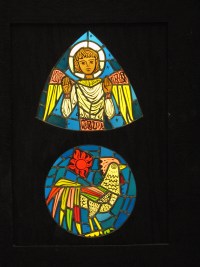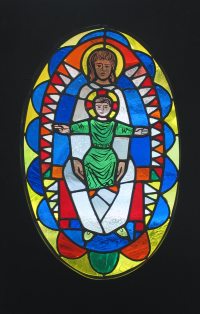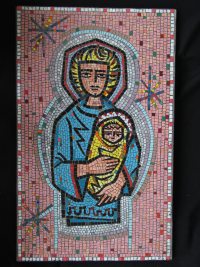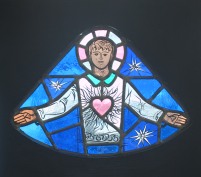 Sixty works to represent any artist's life would usually be a major retrospective, but for the late Father Edward M. Catich, it's only a glimpse. Catich (1906-1979) was an artist, a scholar, a bookmaker and printer, a master calligrapher, a stone carver, a sign painter, a creator of fonts, a great teacher, a stained-glass window maker, a musician on many instruments, a coin collector, a painter, a traveler, an orphan, a child of the Depression, and a parish priest.
Sixty works to represent any artist's life would usually be a major retrospective, but for the late Father Edward M. Catich, it's only a glimpse. Catich (1906-1979) was an artist, a scholar, a bookmaker and printer, a master calligrapher, a stone carver, a sign painter, a creator of fonts, a great teacher, a stained-glass window maker, a musician on many instruments, a coin collector, a painter, a traveler, an orphan, a child of the Depression, and a parish priest.
The Figge Art Museum in Davenport is currently showing more than 60 works from the prolific and celebrated universe of Catich, the master artist/teacher of St. Ambrose University.
Catich had the reputation as one of those rare individuals who made you immediately question just how fully dedicated you were to your art. For him there was no compromise; everything you made had to be to your utmost. Few could keep up with his pace and intensity, or were aware of the full range of his interests and activities.
 Arranging his work chronologically would be difficult, because he rarely signed or dated his art. So the curator, Deba Foxley Leach, has assembled the exhibit according to themes: "ABCs," "Claws," "Help," "Craft," "The Word," "Wings," "Fish," and "Flowers." The exhibition was selected from the collection of nearly 5,000 pieces from St. Ambrose University and can be seen until May 13 in the second-floor Print Gallery.
Arranging his work chronologically would be difficult, because he rarely signed or dated his art. So the curator, Deba Foxley Leach, has assembled the exhibit according to themes: "ABCs," "Claws," "Help," "Craft," "The Word," "Wings," "Fish," and "Flowers." The exhibition was selected from the collection of nearly 5,000 pieces from St. Ambrose University and can be seen until May 13 in the second-floor Print Gallery.
One of his largest works in the show (20 by 25 inches) is the hand-lettered Calligraphic Broadside, in ink and watercolor, with gold and silver leaf, on paper. Quoting from his own seminal book, The Origin of the Serif, in the artwork, he writes of the viewer's importance to the artist, like an audience at a concert, or a crowd at a football game, adding "body English" to the art and influencing the artist. What we bring to the picture is our "kinesthetic empathy," our understanding of the skill of the artist/craftsman and the tools used in making the work. His calligraphy is masterly, well-maintained throughout the piece, and interspersed with little glued-on, hand-drawn holy cards of Catich's own printing, of Mary and the baby Jesus, the three kings, and an angel blowing a big bass saxophone.
Across the hall is St. Phillip with a Basket of Fish, all chiseled lines onto black slate with a sure hand. The cut grooves are brushed in oil colors. It is a rich collection of varied and carved lines, thick and thin, to form a beautiful and energetic whole, glowing in gold, pewter, red, and turquoise.
One feels that Father Catich was not so much a painter of color fields, although he painted watercolors well. One is most aware of his lines and the edges of spaces and forms, as he was primarily a linear artist, at home with the reed, pen, square brush, and chisel.
 His work seems to be the product of his mind and reason, informed by experience and control. Nothing is haphazard or accidental. Everything is perfect and purposeful. As lines indicate thought, and colors emotion, so with Catich the two blended, but for him color and emotion served reason in the colored lines.
His work seems to be the product of his mind and reason, informed by experience and control. Nothing is haphazard or accidental. Everything is perfect and purposeful. As lines indicate thought, and colors emotion, so with Catich the two blended, but for him color and emotion served reason in the colored lines.
Nearby is a fabulous little three-and-a-half-inch-square black-and-white scratchboard, all lines, of two bottles, an apple, and an empty flowerpot on a stand in front of a curtain - a standard still-life setup. But what he has done is electric. The lines and the spaces between the lines radiate vitality, like a great Picasso drawing. With a deep awareness of the still-life tradition, he fills the small areas with a tremendous energy and snap, all by scratching away black to reveal the white area underneath. Shapes, spaces, and volumes are all defined by lines - thick, thin, and repeated - and like Ingres, each line serves the whole with few if any line solos calling attention to themselves. This superb technical process is under the command of his discipline and the power of his seeing.
There are further wonderful examples of his work with the chisel, and five small stained-glass windows. There is a silver chalice from his own hand on a large base with a triangular enameled portrait of a youthful beardless Christ; a set of dancing uppercase letters overlapping and touching on slate, like dancers on a stage before an audience of golden lowercase letters; a straight sonnet of Trajan letters on slate balanced by a linear flower decoration; a mosaic of glass on concrete of a blond-haired Madonna and Christ child in pink and turquoise.
 Also included are parts of his personal life: his black horn-rimmed glasses, three leather visors, some opened sketch books, his harmonica, an oil-paint set, mallets, a large plaster cast he made from Trajan's Column in Rome, and a realistic marble bust of Catich by James Anderson, who taught at St. Ambrose for a few years in the 1980s.
Also included are parts of his personal life: his black horn-rimmed glasses, three leather visors, some opened sketch books, his harmonica, an oil-paint set, mallets, a large plaster cast he made from Trajan's Column in Rome, and a realistic marble bust of Catich by James Anderson, who taught at St. Ambrose for a few years in the 1980s.
But a few steps back, past the elevator, and into the Permanent Collection Gallery near the Grant Wood room, are more Catich pieces worth seeing: three watercolors and a painting on the opposite wall, all part of the museum's collection. One watercolor, Grant Wood Teaching Painting at Stone City, 1933, is featured on the last page of the show's booklet.
Across from this is a beautiful painting, Theophora Icon, of a weary Madonna, and seated on her knees is a wise black Christ, holding a green apple, a white mask hanging on a string from his elbow.
The form reminds us of medieval art, with a strong vertical gold-leaf halo surrounding the figures all around. We notice little incised designs in the golden eclipse, as in a modern illuminated manuscript, of faces; figures; caricatures of animals, fishes, and dogs with hats and goatees; a water beaker; a mousetrap; and an open window hanging in space.
With Father Catich, there were many surprises, a constant, subtle sense of humor, and an infinite attention to craftsmanship in every touch. One can sense the hard looking that went on in every piece, his intensity, and his thoroughness. His work has deep human empathy and yet maintains the distance of art, the seeing with the analyzing, and the observed with the process. In viewing this exhibit, the audience is invited in to admire the strength and breadth of one great man's work.










